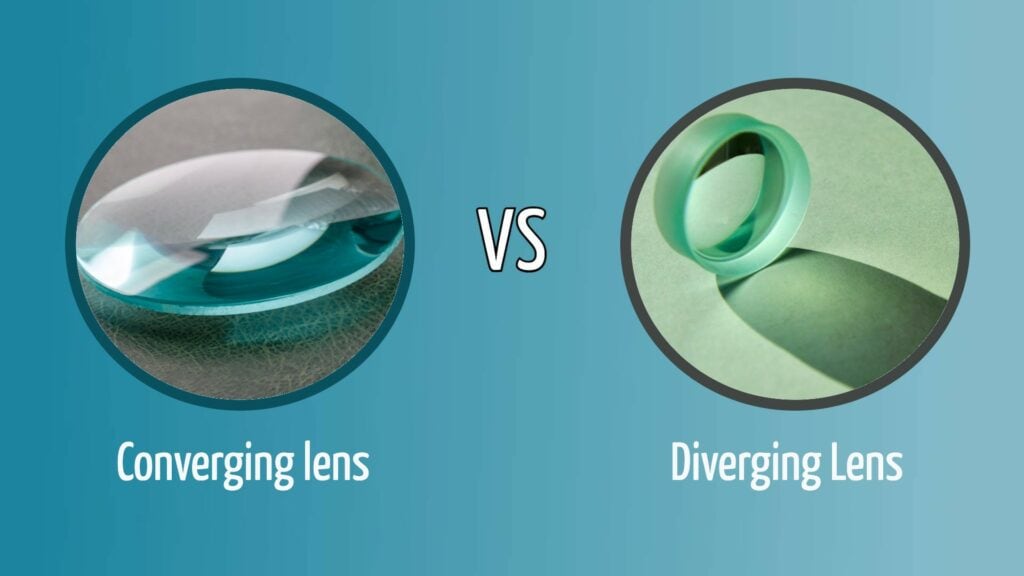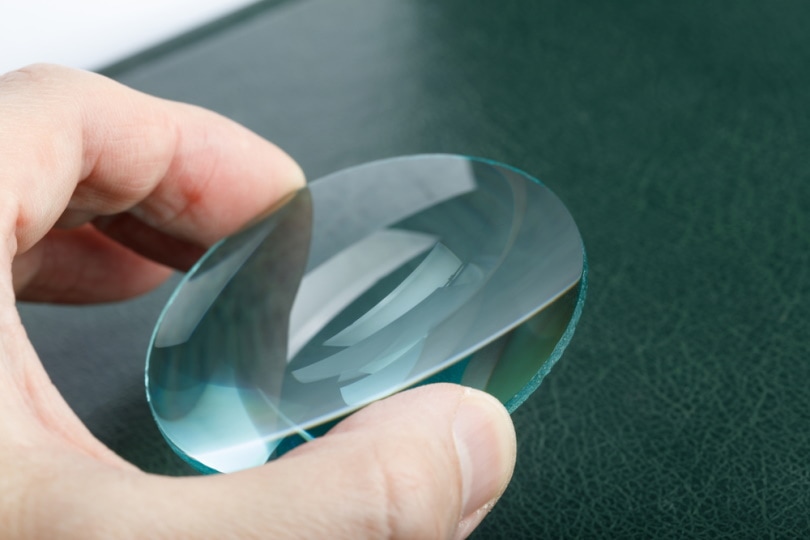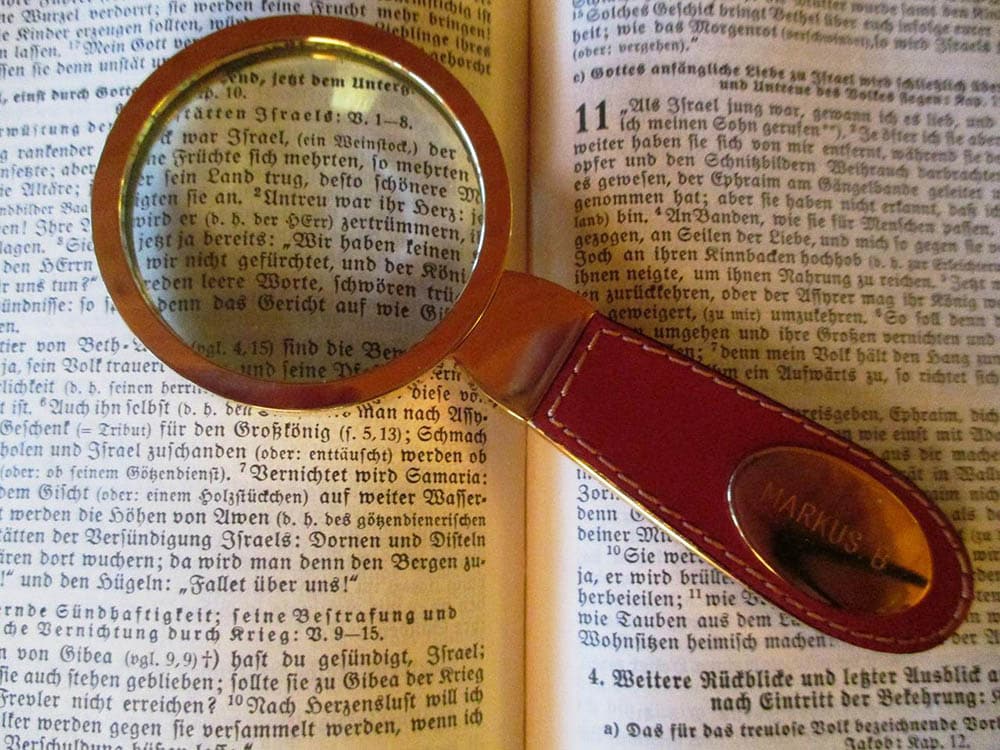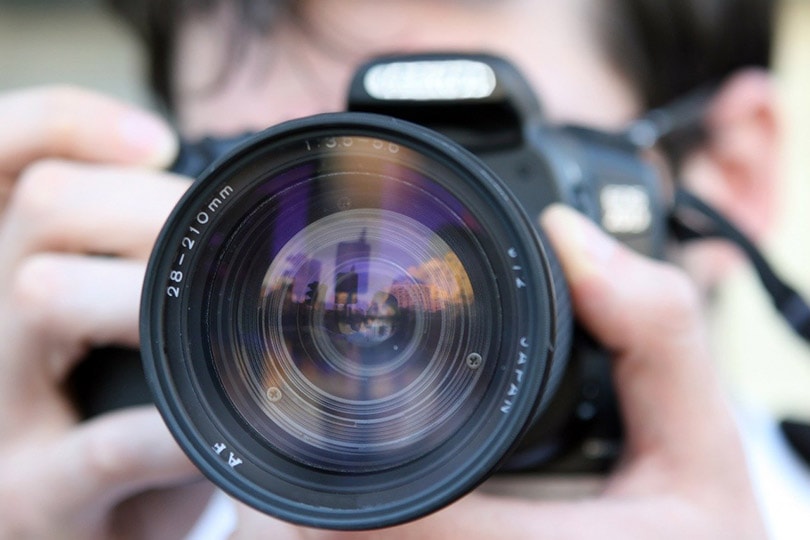Converging vs. Diverging Lens: What’s the Difference?
Last Updated on

When a transparent material such as glass has an appropriate shape, a beam of parallel rays diverges from a point or converges to a point. Such an object is called a lens.
A lens can be either convex or concave. A convex or converging lens is thicker at the center than at the edges, and a concave or diverging lens is thinner at the center than at the edges.
Convex lenses converge a beam of parallel rays to a point, while concave lenses diverge a beam of parallel rays from a point. Therefore, it’s essential to understand the difference between both types of lenses to explain how they serve their purpose.
Below, we explain the difference between converging and diverging lenses. Plus, we discuss their uses and applications.

Overview of Converging Lens
A converging or convex lens converges parallel rays onto a point. The point could be on any side of the lens and is called the focus. Meanwhile, the focal length is the point’s distance from the beam’s optical center (point of origination).

How Does a Converging Lens Form an Image?
When a converging lens forms an image, it is in such a way that a minimum of two refracted rays of light meet on the lens’s focus. For an image to be formed, the following rules must be met:
- The light ray must pass through the focus following the lens refraction. Most importantly, the light ray should parallel the lens’s principal axis.
- Typically, when light refracts, it bends. However, a light ray that passes through the convex lens’s optical center will not bend. Instead, it will be straight. The same applies to the light passing along the principal axis of a converging lens.
- A light ray will go parallel to the lens’s principal axis following refraction.
Types of Converging Lenses
There are three main types of converging lenses. They differ based on the curve of the material and their applications.
- Plano-Convex Lens: A plano-convex lens is curved on one side and flat on the other. It converges light rays parallel to its principal axis and forms a real, inverted, and diminished image. A plano-convex lens is an excellent choice for many optical applications because it is easier to manufacture than a double-convex lens. For example, the robotics, defense, and pharmaceutical industries use these lenses.
- Double Convex Lens: A double convex lens is curved outwards on both ends. It is also called the biconvex lens and has a shorter focal length than a plano-convex lens. Because of their longer focal lengths, these lenses are preferred for cameras, telescopes, and projectors. A longer focal length is necessary when viewing distant objects or subjects, while a shorter focal length is better for close-up viewing.
- Concave-Convex Lens: A concave-convex lens is curved outwards on one end and inward on the other. It helps eliminate the spherical aberrations of other lenses. These lenses are often present in optical devices such as cameras, microscopes, and binoculars.

Applications of Converging Lenses
Convex or converging lenses have a wide range of applications from optometry to photography. Here are some of their uses:
- Hypermetropia Correction: Hypermetropia refers to a condition where the eye cannot focus on near objects. It occurs when the eyeball is too short, or the cornea has too little curvature to form a clear image of something too close to your eye. Eyeglasses with converging lenses help correct far-sightedness.
- Magnification: Converging lenses are also used to magnify objects, such as microscopes and telescopes, since they converge all light to a certain point.
- Photography: Converging lenses focus light from distant objects onto a film or digital sensor in cameras. You’ll find them in camera lenses for far-distance photography, such as wildlife and nature photography. Lenses with a focal length of 400–800 millimeters are ideal for taking pictures of far-away subjects since they make your subject appear closer.
- Other Uses: Besides these typical applications, converging lenses are also used in optical microscopes, binoculars, projectors, and household peepholes.

- Have a wide range of applications
- Used to correct hypermetropia (farsightedness)
- Used in telescopes and microscopes
- Tend to create distortions
- Inaccurate light transfer

Overview of Diverging Lens
A diverging or concave lens has thicker edges and a thinner center. These lenses bend light rays outwards, diverging them from a focus point. They comprise multiple prisms, and each prism’s base points away from the center of the lens.

How Does a Diverging Lens Form an Image?
Diverging lenses only create virtual images since the light rays do not converge to a single focal point after refraction. Since the rays exiting the lens do not converge, it’s impossible to project a virtual image onto a screen.
In simple words, the object will appear to be virtual or behind the lens. Concave images are diminished, virtual, and upright.
Types of Diverging Lenses
There are three types of diverging lenses. Each type has different applications.
- Double Concave Lens: A double or biconcave lens expands the light beam in projection systems. Such a lens is curved inward on both sides. Thus, the curvature radius on both surfaces of the lens is equal.
- Plano-Concave Lens: A plano-concave lens is similar to a plano-convex lens in that one side is flat and the other is curved. However, the curvature is inward, diverging the light passing through it. These lenses increase optical instruments’ focal length, allowing the user to focus on distant objects. Plano-concave lenses are used in many imaging applications, such as microscopes and telescopes
- Concave-Convex Lens: A concave-convex has both concave and convex surfaces. However, the concave face has a larger curvature than the convex side.

Applications of Diverging Lenses
Diverging lenses have many imaging and optical applications. Some of them are as follows.
- Myopia Correctness: Myopia is an eye condition that makes it difficult to see far-away things. As a result, things that are at a distance appear blurry. The condition is also called near-sightedness. Eyeglasses with diverging lenses spread light rays throughout the wearers’ eyes, allowing them to see far-away objects. As a result, the wearer can enjoy clear vision.
- Telescopes: Diverging lenses magnify the images and focus on the objects without distorting them. Thus, they are common in binoculars, eyeglasses, and telescopes.
- Photography: Besides converging lenses, cameras also have diverging lenses since using only one kind can distort the image, making it appear blurry. Therefore, modern cameras use a combination of diverging and converging lenses to get clear and well-focused photos.
- Lasers: Laser beams are in different equipment, such as CD players and scanners. However, laser beams are highly focused, and proper dispersion is needed to ensure the efficient functioning of the equipment. Diverging lenses help disperse the laser beams’ focus so the equipment can work properly. In addition, they widen the beam a laser is emitting, enabling it to cover a larger surface area, which helps the instrument or equipment function well.

- Can be used in combination with concave lenses
- Used in eyeglasses, telescopes, and microscopes
- Enable efficient functioning of lasers and cameras
- Forms virtual images only

Differences Between Converging and Diverging Lenses
There are many differences between converging and diverging lenses. These differences determine the applications and nature of these lenses.
Nature of Lens
The nature of a lens refers to how it refracts or bends the light. Does it diverge the light? Does it converge light rays to a focal point?
Converging lenses converge light rays towards each other. When multiple light rays pass through a converging lens, they are bent towards a similar point.
Meanwhile, diverging lenses scatter or disperse light rays from a central point. When light passes through a diverging lens, the rays spread away from each other.
Thickness
A converging lens is thinner at its edges and thicker in the center. On the other hand, a diverging lens is thinner in the center and thicker on the edges. The thickness of a lens’s surface determines the curvature and refraction of light.

Focal Length
A converging lens has a positive focal length, while a diverging lens has a negative focal length.
The focal length of a converging lens is positive because light rays converge in the opposite direction of their origin. For example, if light rays enter the lens from one side, they will converge and form an image on the other side of the lens.
On the other hand, a negative focal length means that the object and focus point of the lens is on the same side.
When to Use Converging Lenses
Converging lenses are present in eyeglasses, camera lenses, and magnifying glasses. You should use a converging or convex lens when you need to focus light on a central point of an object. For example, magnifying glasses have converging lenses. Light passes through the converging lens and focuses on the lens’s focal point if the magnifying glass is at just the proper distance.
As a result, the focal point reaches the object, magnifying it. The magnification allows you to see even smaller objects. However, the downside is that converging lenses distort the image, making it appear blurry.
Similarly, converging lenses are also helpful in focusing the light correctly on the inside of the eye. A far-sighted person has difficulty seeing objects close to them because their eye forms the image far behind their retina.
As a result, they cannot closely focus on nearby objects. When you place a converging lens in front of this individual’s eye, it refracts or bends light rays, shortening their focal point. Instead of forming an image behind the retina, the light creates an image on the retina, allowing the individual to see nearby objects.

When to Use Diverging Lenses
Diverging lenses come in handy when you need to disperse the light rays. For example, if a person has near-sightedness and cannot see distant objects clearly, a diverging lens can fix their vision.
When you place eyeglasses with a diverging lens in front of this person’s eyes, the lens spreads or diverges light, allowing it to reach their eyeball. As a result, a clear image forms on the retina.
Similarly, diverging lenses also disperse light rays in medical equipment and scanners where the user needs to access a particular area. Again, the diverging lens disperses light rays, ensuring the instrument’s optimal functioning.
Diverging lenses are also helpful in cases where you need to spread or magnify the amount of light produced. An excellent example of this is a flashlight. The diverging lens in front of a flashlight diverges light rays, increasing the light’s radius. So, you have a broader beam that lets you see objects over a large surface area.
As mentioned earlier, converging lenses distort images. That’s why you need to use a diverging lens with them to prevent image distortion. The phenomenon is used in photography, where image clarity matters a lot.

Converging vs. Diverging Lens: A Comparison
| Features | Converging | Diverging |
| Nature | Convex | Concave |
| Use in Eyeglasses | Corrects far-sightedness | Corrects short-sightedness |
| Focal Length | Positive | Negative |
| Shape | Thicker at the center | Thicker at the edges |
| Example | Cameras | Flashlights |

Conclusion
It’s evident that converging and diverging lenses differ in their nature, focal length, structure, applications, and image formation mechanism. Nevertheless, both of these lenses have extensive optical and imaging uses. As a result, they have applications in many industries, including but not limited to pharmaceuticals, imaging, healthcare, robotics, and photography.
Featured Image Credit: (Left) Feng Yu, Shutterstock (Right) SuperPuay, Shutterstock
About the Author Jeff Weishaupt
Jeff is a tech professional by day, writer, and amateur photographer by night. He's had the privilege of leading software teams for startups to the Fortune 100 over the past two decades. He currently works in the data privacy space. Jeff's amateur photography interests started in 2008 when he got his first DSLR camera, the Canon Rebel. Since then, he's taken tens of thousands of photos. His favorite handheld camera these days is his Google Pixel 6 XL. He loves taking photos of nature and his kids. In 2016, he bought his first drone, the Mavic Pro. Taking photos from the air is an amazing perspective, and he loves to take his drone while traveling.
Related Articles:
How to Clean a Refractor Telescope: Step-by-Step Guide
How to Clean a Telescope Eyepiece: Step-by-Step Guide
How to Clean a Rifle Scope: 8 Expert Tips
Monocular vs Telescope: Differences Explained (With Pictures)
What Is a Monocular Used For? 8 Common Functions
How to Clean a Telescope Mirror: 8 Expert Tips
Brightfield vs Phase Contrast Microscopy: The Differences Explained
SkyCamHD Drone Review: Pros, Cons, FAQ, & Verdict
